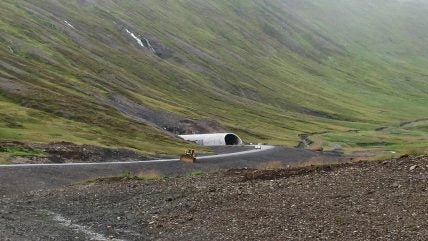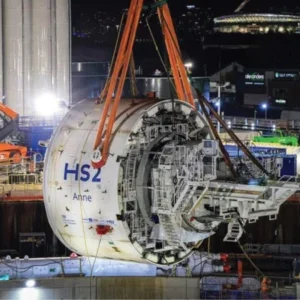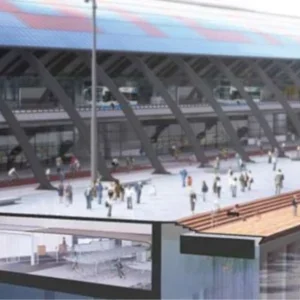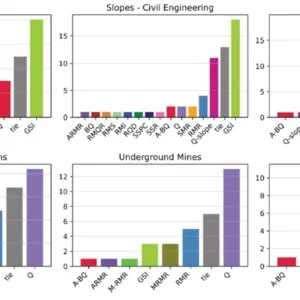
Given the remoteness of the small towns of Siglufjordur and Olafsfjordur and the need to improve their transport links with other parts of North Iceland – especially Akureyri, the main town of the region and the country’s fourth largest – a major tunnel project had long been in preparation by the Government, through the road administration, Vegagerdin.
Of the three alternative routes under consideration in the early planning about a decade ago, all of which called for two consecutive tunnels to negotiate the mountain ranges and valleys, the route chosen would require construction of 10,575m of tunnel in total, plus portals, representing neither the shortest nor the longest of the tunnelling options. It was, however, the most direct and lowest elevation of the alternatives, which is of no little importance in the heavy snows and ICE of the country’s near-Arctic winter climate.
The alignment chosen would briefly pass through Hedinsfjordur valley, a remote and uninhabited area of great natural beauty separated from each town by a mountain range. On the north side of the valley comes a tunnel mined for 3650m from Siglufjordur, which would give it its name, and it would have 225m of concrete portals – 100m of which would show at Hedinfjordur outside of winter. At the opposite side of the valley the longer of the two tunnels would be built, being mined for 6925m through the basalt separating Hedinsfjordur from Olafsfjordur. It, too, would have 225m of portals.
With each tunnel named after the nearest town, the overall scheme drew the name of the valley in the middle – Hedinsfjordur Tunnel.
Design
As with all road tunnels in Iceland, the Hedinsfjordur Tunnel was designed and would be constructed according to the Nordic tunnelling concept. From the first steps of the early studies through to route investigation and concept development until the detailed brief was finalised, the planning and design process for the scheme took about 12 years.
Vegagerdin was assisted in the process by Icelandic design companies Mannvit, Verkis, Raftakn, Verkfraedistofa Nordurlands and Teikn. The geological consultant was Jardfraedistofan Reykjavik, and construction supervision was provided by GeoTek.
The tunnels broadly run northwest to southeast and their horizontal alignments are almost in a straight line apart from being offset slightly where they break out into the open to cross Hedinsfjordur valley. In terms of the vertical alignment, the roads slopes into and out of the valley at 3 per cent and the remainder of each tunnel drop from its crest at 1 per cent towards the towns.
Chainage along the alignment is measured from the northwest, Siglufjordur end where the new road connects with the existing. The route rises on rockfill across Fjardara valley at the head of Siglufjordur fjord into Skutudalur valley on the approach to Chainage 2.275km and the 125m long portal structure, constructed in open cut. In the mined tunnel the road continues to rise, at 1 per cent Slope, to crest at Chainage 4.025km and fall off at 3 per cent towards Hedinsfjordur valley. The tunnel is named after the nearest town – Siglufjordur.
The alignment cross the valley on a rockfill embankment and crosses a river with a 14m long reinforced concrete single span bridge. From there it weaves up towards the next portal, and tunnel – Olafsfjordur (‘Olafs’) Tunnel – at Chainage 6.775km. It rises at 1.39%slope to crest at Chainage 8.9km. After this point it falls away towards the town of Olafsfjordur, exiting the portal at Chainage 13.925km and tying in to the existing road at Chainage 14.1km.
Hedinsfjordur Tunnel is a two-lane tube (one lane of traffic in either direction) with a cross sectional area of 52.83m2 and clearance of Norwegian profile T 8.5. At regular intervals of around 500m along the tunnels there are widened sections, referred to and equipped as Emergency Bays. In Siglu Tunnel there are six bays and 13 along Olafs Tunnel, and they have a cross sectional area of 75.25m2. Three of the bays are extra wide to be large turning areas.
The excavation would be undertaken by drill and blast method and guidance on support was for use of shotcrete and varying concentrations of rockbolts, as required. Iceland has a minimal, lighter approach to support along the Nordic tunnelling lines, explains Bjorn A. Hardarson of Icelandic consultant GeoTek, which provided technical and contract supervision services to the client – akin to a Resident Engineer, monitoring but also advising on permanent support in the tunnels. He has extensive experience on road and hydro tunnels in Iceland. While wryly emphasising that the approach is not to build heavily reinforced pipes as tunnels, he notes that there has been a gradual increase in support.
Waterproof and frost protection (WFP) lining protection was to be installed, positioned proud of the rock with positioning bolts and leaving a water drip-zone gap. A thin layer of shotcrete would complete the permanent lining.
Procurement and construction
Procurement for the construction contract got underway in 2005 but it wasn’t the first time. Four years earlier the project had been put out to tender in the EU zone and in 2003 the bids were opened. However, the Government postponed the construction phase of the scheme.
A prequalification process began in 2005. Tenders were issued early the following year. Five bids were received and were opened in March 2006.
A joint venture of Czech contractor Metrostav and local firm Hafell submitted the lowest tender and a contract for the construction works was signed with them in May 2006. The contract value was ISK 5.74bn (USD 91.53M in 2006 exchange rates). The next nearest was ISK 5.85bn and the others were more than ISK 6.1bn – the highest being almost ISK 9bn.
The contract is on a conventional unit price basis with the client responsible for quantities, ground conditions, key changes and standard Icelandic contract conditions for civil engineering projects. The technical specification and all contract documents were written in Icelandic since 2003 when the country moved away from FIDIC contract conditions.
Works started in June 2006 with Metrostav undertaking the underground works and Hafell the surface works, including open cut of the portal areas in preparations for excavation.
In total, the new route would add a direct route of just over 14km to the road network and link Siglufjordur and Olafsfjordur but until then the contractor had to face the circuitous journey between the towns like the locals – the shortest trip around the coastal and mountain valleys covering 62km in good weather but with harsh winter conditions the trip each way would stretch to 260km. As a consequence, the constructions camps set up near the portals were quite independent, and the construction supervisor operated in a similar fashion with two offices.
It would turn out that such commuting would be the lesser of their challenges. Very difficult ground conditions with large, high pressure inflows in Olafs Tunnel led to setbacks and tunnelling challenges which came to be understandable to all concerned as creating delay against the original programme to complete the entire project by late 2009. The groundwater problems were eventually overcome through persistence and extra application of expensive chemical grout. The tunnellers’ tenacity brought recognition to Metrostav, from the client and construction supervisor and the communities.
Hardarson notes that the inflows caused ‘huge work’ and was the prime challenge among others that included high-pressure, low water temperatures and achieving grouting solutions in the jointed rock. While aspects of these conditions have been seen in some other road tunnels, he says these were ‘difficult conditions’.
A further challenge came from outside during the contract period, however, when the economy of Iceland and its currency suffered their own tectonic shocks, hitting the exchange rates.
Local engineering nous was key to a fresh approach on the WFP lining installation, including positioning bolts. The works were undertaken by local firm VK Contractors – their staff also worked on the concrete tunnel portal construction using its own, custom-made travelling formwork. The name behind the technical preparation and innovations is Helgi Valur Einarsson, managing director of VK. Hafell completed the drainage and road surfacing works through the tunnels.
Construction was completed in September 2010, and Hedinsfjordur Tunnel was officially opened on 2 October.
Cross section of the regular and emergency bays for the Olafsfjordur and Siglufjordur road tunnels on the Hedinsfjordur project Hedinsfjordur road tunnel project was built over 2006-10 in remote North Iceland and overcame significant groundwater challenges Metrostav divisional director Vaclav Soukup and Vegagerdin director general Hreinn Haraldsson at opening GeoTek’s Bjorn A Hardarson and Oddur Sigurdsson provided the technical and contract supervision services for the client, Vegagerdin Jon Magnusson, client representative to the Hedinsfjordur project Ermin Stehlik (right), Metrostav’s project manager for Hedinsfjordur Tunnel Johann Gunar Stefansson, general manager of Hafell, which joint ventured with Metrostav on the Hedinsfjordur project, being interviewed by local media at opening






